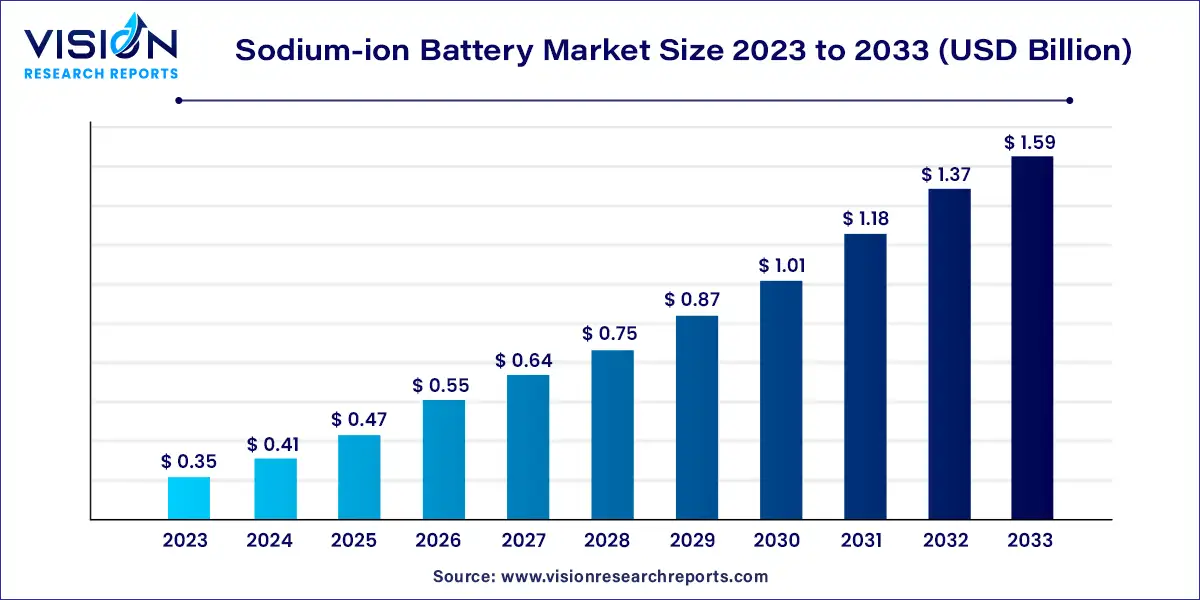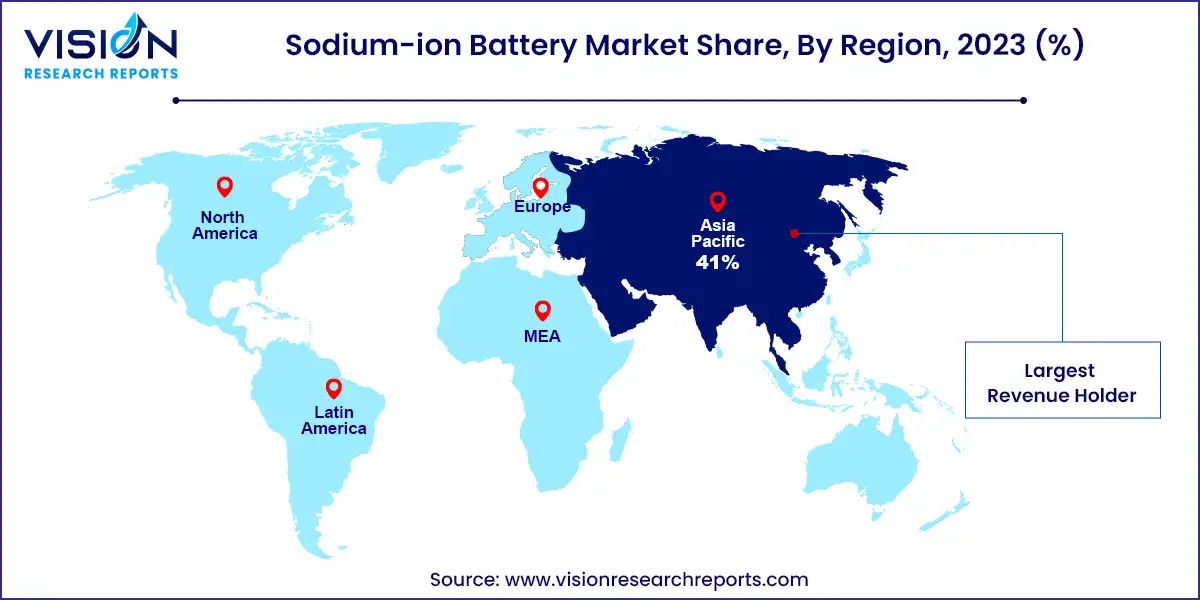The global sodium-ion battery market was valued at USD 0.35 billion in 2023 and it is predicted to surpass around USD 1.59 billion by 2033 with a CAGR of 16.35% from 2024 to 2033.

The sodium-ion battery market is gaining momentum as a promising alternative to lithium-ion batteries, primarily due to the abundant global supply of sodium and its cost-effectiveness. This market is driven by increasing demand for energy storage solutions that are sustainable and affordable across various applications.
The sodium-ion battery market is poised for substantial growth driven by the abundant global reserves of sodium ensure a stable and cost-effective supply chain, reducing dependency on limited lithium resources. Secondly, advancements in manufacturing technologies are driving down production costs, making sodium-ion batteries increasingly competitive in the energy storage sector. Thirdly, the growing integration of renewable energy sources is boosting demand for efficient and scalable energy storage solutions, where sodium-ion batteries offer a viable alternative. These factors collectively contribute to a promising outlook for the sodium-ion battery market, with significant opportunities for expansion across various applications and regions globally.
Energy storage emerged as the largest end-use segment in 2023, capturing a market share of approximately 51%, and is anticipated to experience robust growth in the coming years. Sodium-ion batteries are increasingly recognized for their efficiency and cost-effectiveness in storing renewable energy, from grid-level applications to residential energy storage systems. With the rising prevalence of renewable energy sources like solar and wind power, there is a growing demand for reliable energy storage solutions, thus driving the adoption of sodium-ion batteries in utility-scale energy projects. Additionally, these batteries are deployed in off-grid scenarios to provide dependable power in remote areas and support critical infrastructure during power disruptions.
Moreover, sodium-ion batteries are pivotal in the electrification of transportation, facilitating the shift towards sustainable mobility. As the automotive industry embraces electric vehicles (EVs), sodium-ion batteries present an attractive alternative to lithium-ion options due to their abundance and potentially lower costs. With ongoing advancements in sodium-ion battery technology and the expansion of EV charging infrastructure, these batteries are set to play a significant role in powering the next generation of vehicles, contributing to reduced emissions and a greener transportation ecosystem.
In 2023, the sodium-sulfur battery segment led with a substantial revenue share of approximately 52% and is expected to demonstrate strong growth in the forecast period. Known for their high energy density and long cycling stability, sodium-sulfur batteries are well-suited for large-scale energy storage applications such as grid-level storage and EVs. Their robust performance, coupled with abundant and cost-effective raw materials, positions sodium-sulfur batteries as a competitive alternative to lithium-ion counterparts, especially in applications requiring high energy density and cost efficiency.
However, challenges persist in scaling up sodium-sulfur battery technology, primarily due to the high operating temperatures and safety considerations associated with molten sodium and sulfur. Addressing these challenges through advancements in materials science and engineering could broaden the commercial adoption of sodium-sulfur batteries, driving further market growth. With continuous research and development efforts aimed at enhancing performance and safety features, sodium-sulfur batteries hold significant promise in reshaping the energy storage landscape to meet evolving needs in renewable energy integration and global electrification initiatives.
The Asia Pacific sodium ion battery market emerged as the global leader, commanding a significant revenue share of 41% in 2023. This region is poised to maintain its dominance throughout the forecast period, supported by robust manufacturing infrastructure and a well-established supply chain network that ensures efficient production and distribution of sodium-ion batteries. Government policies aimed at promoting renewable energy adoption and the electrification of transportation further stimulate market demand in Asia Pacific. Additionally, rapid urbanization and industrialization in countries like China, Japan, and South Korea are driving up energy consumption levels, thereby increasing the demand for reliable energy storage solutions and fostering market expansion in the region.

The North American sodium-ion battery market is poised for substantial growth, expected to achieve a compound annual growth rate (CAGR) exceeding 19.03% from 2024 to 2033. Government support for clean energy technologies, including robust investments in battery research and development, is expected to significantly bolster market expansion in the region.
By Technology
By End-use
By Region
Chapter 1. Introduction
1.1. Research Objective
1.2. Scope of the Study
1.3. Definition
Chapter 2. Research Methodology
2.1. Research Approach
2.2. Data Sources
2.3. Assumptions & Limitations
Chapter 3. Executive Summary
3.1. Market Snapshot
Chapter 4. Market Variables and Scope
4.1. Introduction
4.2. Market Classification and Scope
4.3. Industry Value Chain Analysis
4.3.1. Raw Material Procurement Analysis
4.3.2. Sales and Distribution Channel Analysis
4.3.3. Downstream Buyer Analysis
Chapter 5. COVID 19 Impact on Sodium-ion Battery Market
5.1. COVID-19 Landscape: Sodium-ion Battery Industry Impact
5.2. COVID 19 - Impact Assessment for the Industry
5.3. COVID 19 Impact: Global Major Government Policy
5.4. Market Trends and Opportunities in the COVID-19 Landscape
Chapter 6. Market Dynamics Analysis and Trends
6.1. Market Dynamics
6.1.1. Market Drivers
6.1.2. Market Restraints
6.1.3. Market Opportunities
6.2. Porter’s Five Forces Analysis
6.2.1. Bargaining power of suppliers
6.2.2. Bargaining power of buyers
6.2.3. Threat of substitute
6.2.4. Threat of new entrants
6.2.5. Degree of competition
Chapter 7. Competitive Landscape
7.1.1. Company Market Share/Positioning Analysis
7.1.2. Key Strategies Adopted by Players
7.1.3. Vendor Landscape
7.1.3.1. List of Suppliers
7.1.3.2. List of Buyers
Chapter 8. Global Sodium-ion Battery Market, By Technology
8.1. Sodium-ion Battery Market, by Technology, 2024-2033
8.1.1. Sodium Sulfur Battery
8.1.1.1. Market Revenue and Forecast (2021-2033)
8.1.2. Sodium Salt Battery
8.1.2.1. Market Revenue and Forecast (2021-2033)
8.1.3. Sodium Air Battery
8.1.3.1. Market Revenue and Forecast (2021-2033)
Chapter 9. Global Sodium-ion Battery Market, By End-use
9.1. Sodium-ion Battery Market, by End-use, 2024-2033
9.1.1. Consumer Electronics
9.1.1.1. Market Revenue and Forecast (2021-2033)
9.1.2. Automotive
9.1.2.1. Market Revenue and Forecast (2021-2033)
9.1.3. Industrial
9.1.3.1. Market Revenue and Forecast (2021-2033)
9.1.4. Energy Storage
9.1.4.1. Market Revenue and Forecast (2021-2033)
9.1.5. Others
9.1.5.1. Market Revenue and Forecast (2021-2033)
Chapter 10. Global Sodium-ion Battery Market, Regional Estimates and Trend Forecast
10.1. North America
10.1.1. Market Revenue and Forecast, by Technology (2021-2033)
10.1.2. Market Revenue and Forecast, by End-use (2021-2033)
10.1.3. U.S.
10.1.3.1. Market Revenue and Forecast, by Technology (2021-2033)
10.1.3.2. Market Revenue and Forecast, by End-use (2021-2033)
10.1.4. Rest of North America
10.1.4.1. Market Revenue and Forecast, by Technology (2021-2033)
10.1.4.2. Market Revenue and Forecast, by End-use (2021-2033)
10.2. Europe
10.2.1. Market Revenue and Forecast, by Technology (2021-2033)
10.2.2. Market Revenue and Forecast, by End-use (2021-2033)
10.2.3. UK
10.2.3.1. Market Revenue and Forecast, by Technology (2021-2033)
10.2.3.2. Market Revenue and Forecast, by End-use (2021-2033)
10.2.4. Germany
10.2.4.1. Market Revenue and Forecast, by Technology (2021-2033)
10.2.4.2. Market Revenue and Forecast, by End-use (2021-2033)
10.2.5. France
10.2.5.1. Market Revenue and Forecast, by Technology (2021-2033)
10.2.5.2. Market Revenue and Forecast, by End-use (2021-2033)
10.2.6. Rest of Europe
10.2.6.1. Market Revenue and Forecast, by Technology (2021-2033)
10.2.6.2. Market Revenue and Forecast, by End-use (2021-2033)
10.3. APAC
10.3.1. Market Revenue and Forecast, by Technology (2021-2033)
10.3.2. Market Revenue and Forecast, by End-use (2021-2033)
10.3.3. India
10.3.3.1. Market Revenue and Forecast, by Technology (2021-2033)
10.3.3.2. Market Revenue and Forecast, by End-use (2021-2033)
10.3.4. China
10.3.4.1. Market Revenue and Forecast, by Technology (2021-2033)
10.3.4.2. Market Revenue and Forecast, by End-use (2021-2033)
10.3.5. Japan
10.3.5.1. Market Revenue and Forecast, by Technology (2021-2033)
10.3.5.2. Market Revenue and Forecast, by End-use (2021-2033)
10.3.6. Rest of APAC
10.3.6.1. Market Revenue and Forecast, by Technology (2021-2033)
10.3.6.2. Market Revenue and Forecast, by End-use (2021-2033)
10.4. MEA
10.4.1. Market Revenue and Forecast, by Technology (2021-2033)
10.4.2. Market Revenue and Forecast, by End-use (2021-2033)
10.4.3. GCC
10.4.3.1. Market Revenue and Forecast, by Technology (2021-2033)
10.4.3.2. Market Revenue and Forecast, by End-use (2021-2033)
10.4.4. North Africa
10.4.4.1. Market Revenue and Forecast, by Technology (2021-2033)
10.4.4.2. Market Revenue and Forecast, by End-use (2021-2033)
10.4.5. South Africa
10.4.5.1. Market Revenue and Forecast, by Technology (2021-2033)
10.4.5.2. Market Revenue and Forecast, by End-use (2021-2033)
10.4.6. Rest of MEA
10.4.6.1. Market Revenue and Forecast, by Technology (2021-2033)
10.4.6.2. Market Revenue and Forecast, by End-use (2021-2033)
10.5. Latin America
10.5.1. Market Revenue and Forecast, by Technology (2021-2033)
10.5.2. Market Revenue and Forecast, by End-use (2021-2033)
10.5.3. Brazil
10.5.3.1. Market Revenue and Forecast, by Technology (2021-2033)
10.5.3.2. Market Revenue and Forecast, by End-use (2021-2033)
10.5.4. Rest of LATAM
10.5.4.1. Market Revenue and Forecast, by Technology (2021-2033)
10.5.4.2. Market Revenue and Forecast, by End-use (2021-2033)
Chapter 11. Company Profiles
11.1. Faradion Limited
11.1.1. Company Overview
11.1.2. Product Offerings
11.1.3. Financial Performance
11.1.4. Recent Initiatives
11.2. AMTE Power Plc
11.2.1. Company Overview
11.2.2. Product Offerings
11.2.3. Financial Performance
11.2.4. Recent Initiatives
11.3. Natron Energy, Inc.
11.3.1. Company Overview
11.3.2. Product Offerings
11.3.3. Financial Performance
11.3.4. Recent Initiatives
11.4. Altris AB
11.4.1. Company Overview
11.4.2. Product Offerings
11.4.3. Financial Performance
11.4.4. LTE Scientific
11.5. Tiamat Energy
11.5.1. Company Overview
11.5.2. Product Offerings
11.5.3. Financial Performance
11.5.4. Recent Initiatives
11.6. Li-FUN Technology Corporation Limited
11.6.1. Company Overview
11.6.2. Product Offerings
11.6.3. Financial Performance
11.6.4. Recent Initiatives
11.7. Contemporary Amperex Technology Co. Limited (CATL)
11.7.1. Company Overview
11.7.2. Product Offerings
11.7.3. Financial Performance
11.7.4. Recent Initiatives
11.8. HiNa Battery Technology Co., Ltd
11.8.1. Company Overview
11.8.2. Product Offerings
11.8.3. Financial Performance
11.8.4. Recent Initiatives
11.9. Indigenous Energy Storage Technologies Pvt. Ltd. (Indi Energy)
11.9.1. Company Overview
11.9.2. Product Offerings
11.9.3. Financial Performance
11.9.4. Recent Initiatives
11.10. Aquion Energy
11.10.1. Company Overview
11.10.2. Product Offerings
11.10.3. Financial Performance
11.10.4. Recent Initiatives
Chapter 12. Research Methodology
12.1. Primary Research
12.2. Secondary Research
12.3. Assumptions
Chapter 13. Appendix
13.1. About Us
13.2. Glossary of Terms
 Cross-segment Market Size and Analysis for
Mentioned Segments
Cross-segment Market Size and Analysis for
Mentioned Segments
 Additional Company Profiles (Upto 5 With No Cost)
Additional Company Profiles (Upto 5 With No Cost)
 Additional Countries (Apart From Mentioned Countries)
Additional Countries (Apart From Mentioned Countries)
 Country/Region-specific Report
Country/Region-specific Report
 Go To Market Strategy
Go To Market Strategy
 Region Specific Market Dynamics
Region Specific Market Dynamics Region Level Market Share
Region Level Market Share Import Export Analysis
Import Export Analysis Production Analysis
Production Analysis Others
Others